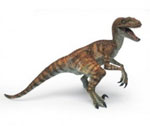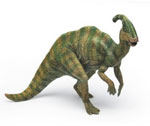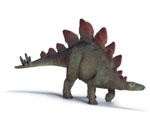
Some of Our
Toy Dinosaur Collection




|
|
The Parasaurolophus
 As is the case with most dinosaurs, the skeleton of Parasaurolophus is incompletely known. The length of the type specimen of P. walkeri is estimated at 9.5 meters (31 ft). Its skull is about 1.6 meters (5.2 ft) long, including the crest, whereas the type skull of P. tubicen is over 2.0 meters (6.6 ft) long, indicating a larger animal. Its weight is estimated at 2.5 tonnes (2.7 tons). Its single known forelimb was relatively short for a hadrosaurid, with a short but wide shoulder blade. The thighbone measures 103 centimeters (3.38 ft) long in P. walkeri and is robust for its length when compared to other hadrosaurids. The upper arm and pelvic bones were also heavily built. As is the case with most dinosaurs, the skeleton of Parasaurolophus is incompletely known. The length of the type specimen of P. walkeri is estimated at 9.5 meters (31 ft). Its skull is about 1.6 meters (5.2 ft) long, including the crest, whereas the type skull of P. tubicen is over 2.0 meters (6.6 ft) long, indicating a larger animal. Its weight is estimated at 2.5 tonnes (2.7 tons). Its single known forelimb was relatively short for a hadrosaurid, with a short but wide shoulder blade. The thighbone measures 103 centimeters (3.38 ft) long in P. walkeri and is robust for its length when compared to other hadrosaurids. The upper arm and pelvic bones were also heavily built.
Like other hadrosaurids, it was able to walk on either two legs or four. It probably preferred to forage for food on four legs, but ran on two. The neural spines of the vertebrae were tall, as was common in lambeosaurines; tallest over the hips, they increased the height of the back. Skin impressions are known for P. walkeri, showing uniform tubercle-like scales but no larger structures.
The most noticeable feature was the cranial crest, which protruded from the rear of the head and was made up of the premaxilla and nasal bones. The P. walkeri type specimen has a notch in the neural spines near where the crest would hit the back, but this may be a pathology peculiar to this individual. William Parks, who named the genus, hypothesized that a ligament ran from the crest to the notch to support the head. Although this idea seems unlikely, Parasaurolophus is sometimes restored with a skin flap from the crest to the neck. The crest was hollow, with distinct tubes leading from each nostril to the end of the crest before reversing direction and heading back down the crest and into the skull. The tubes were simplest in P. walkeri, and more complex in P. tubicen, where some tubes were blind and others met and separated. While P. walkeri and P. tubicen had long crests with only slight curvature, P. cyrtocristatus had a short crest with a more circular profile.
— from Wikipedia
|